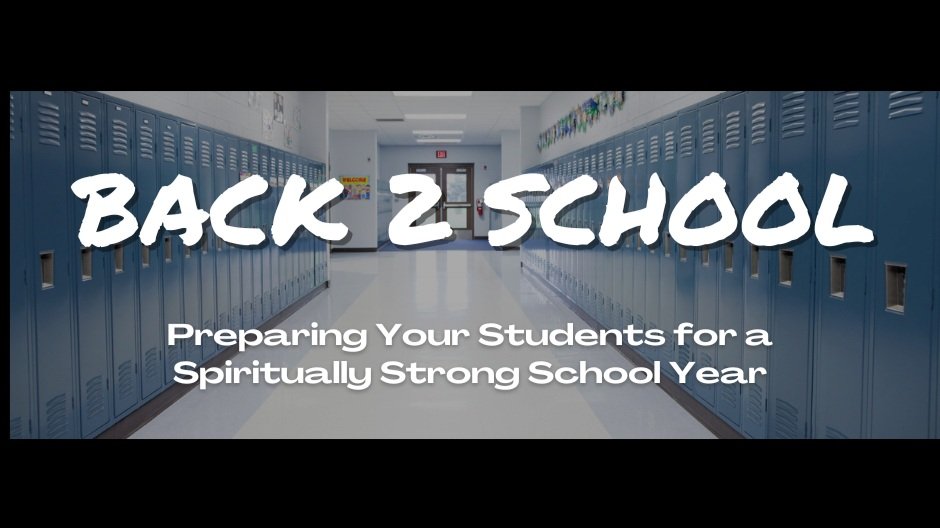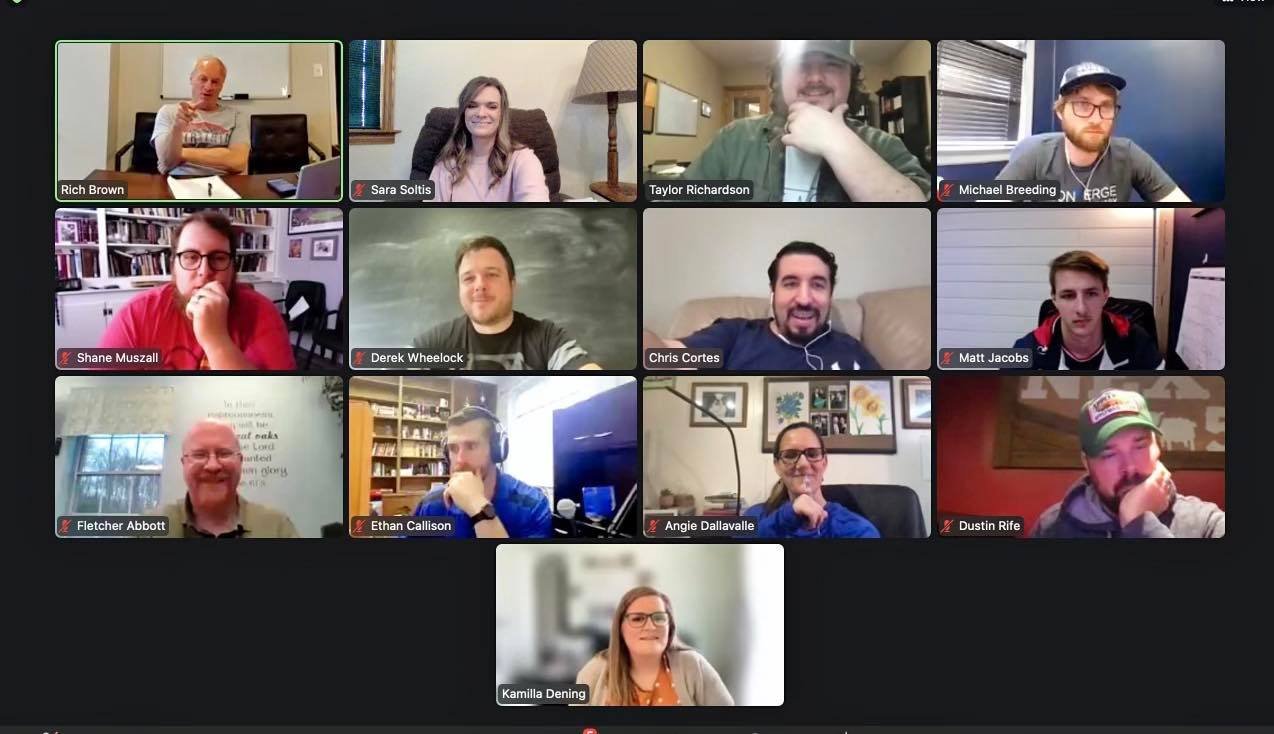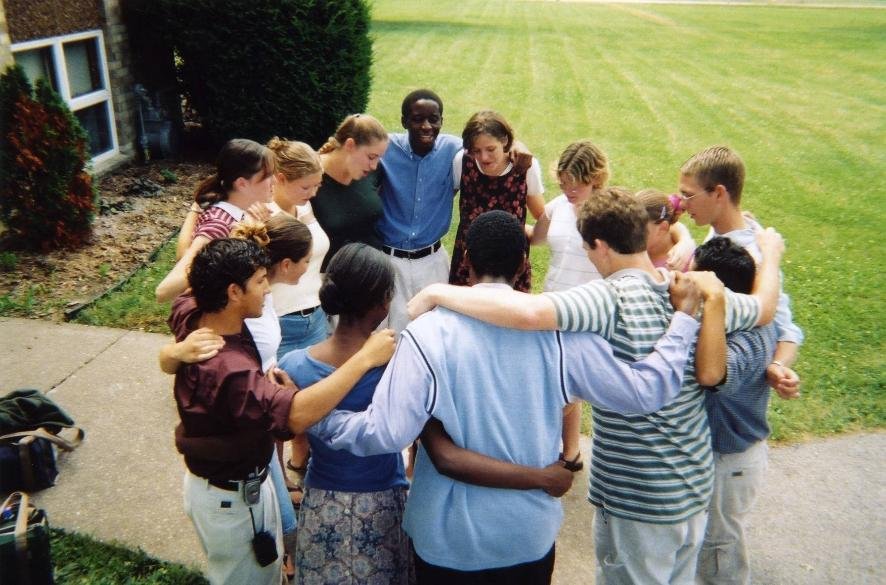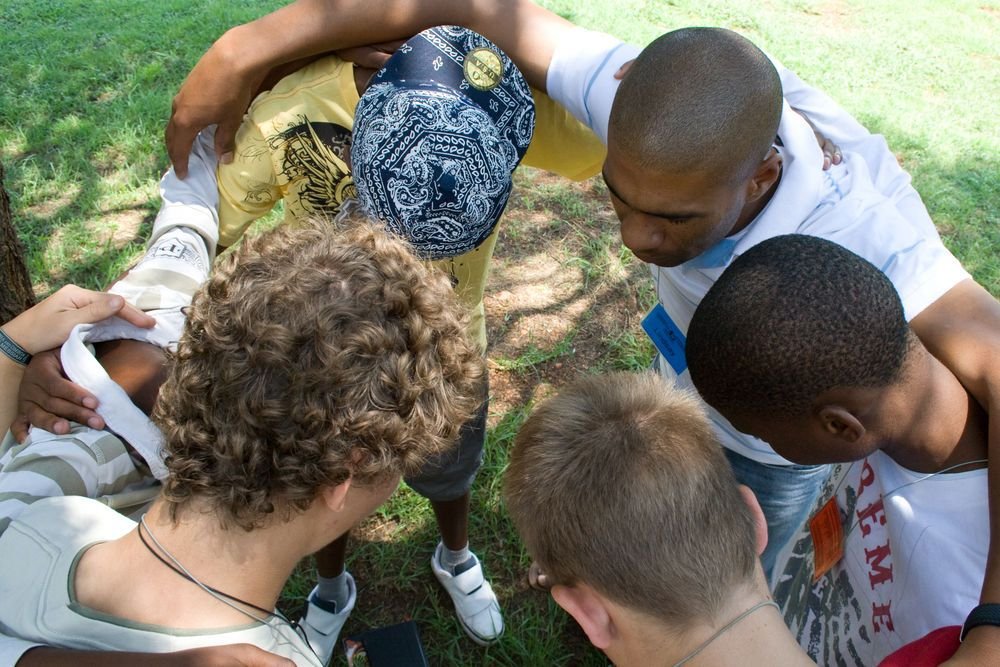Remaining Present in the Midst of THE Presents
For those of us in ministry, our busiest ministry season is during the time of “Silent Night” and yet our lives are anything but silent! As we are so busy serving Jesus, are we neglecting Jesus…and our families? This article is not a guilt trip, just the opposite. Take five minutes and read Sara’s encouraging article on how we can be present in the middle of the presents.
We have all been there, haven’t we? In fact, you may even be there right now; wrapped up tightly in a ministry of presence amidst the most wonderful time of the year. After all, the Christmas season abounds with opportunity to share the “good news of great joy” that is for all of mankind (Luke 2:10). As ministry leaders, we can attest to the “inexpressible and glorious joy” that comes from believing the Good News of our Savior (1 Pet. 1:8). It is this inexpressible joy that so often compels us to take hold of every opportunity to lead and love others in the truth of Christ. While Christmas bursts at the seams with such opportunity, we can easily get caught up in the hustle and bustle of all that is good in this season of ministry. Add to this the personal dynamic of your current season of life and it is quite possible that you’ll be home for Christmas, if only in your dreams!
Yet, there is a call for our intentional presence that extends beyond our volunteer or vocational ministry. This call resides in your heart and in mine, as well as in the hearts of our loved ones. Although we long to be fully engaged and present for our loved ones and those we serve during the holidays, it can prove challenging to faithfully steward all that the Lord has entrusted to us both personally and in ministry. Perhaps you can relate? If so, rest assured that you are not alone. More than this, be encouraged! While our ministry contexts and life circumstances undoubtedly differ, we can remain present in the midst of the presents this Christmas season.
At the very foundation of an effective ministry is a prepared heart vitally rooted in Christ. In Scripture, Jesus reveals, “I am the vine; you are the branches. If you remain in me and I in you, you will bear much fruit; apart from me you can do nothing” (John 15:5). In a season that abounds with plenty of good opportunity, it can be a challenge to discern what is best. Yet, there is a call for our intentional presence to always remain in relationship with our Savior, the “Word made flesh,” and the very one we celebrate this Christmas (John 1:14). Surely, the call for our presence comes from all directions outside of us, especially during the holidays. Wisdom, however, is found in responding first to the call of Jesus to remain in him. While the time will come for each of us to step into the realm of being present for others this Christmas season, may we run first into the presence of Jesus, the “author and perfector of our faith” (Heb. 12:2).
As we prepare our hearts each day and intentionally prioritize remaining in Christ, our ministry of presence to others this Christmas may produce eternal fruit for the glory of God (1 Cor. 10:31; Col. 3:17). Without question, navigating a ministry of presence to both our loved ones and those we are called to serve requires the Lord’s wisdom (James 1:5).
In transparency, our family was hurled into student ministry in a whirlwind! While my husband was a teacher, he was also in seminary in pursuit of military chaplaincy. To our surprise, the Lord used this training to lead my husband into vocational ministry in the church. The next thing I knew, I was the wife of a student pastor. This was such an exciting yet busy time as we entered this season with young children, with more on the way, all while I was in nursing school. Phew! I was (and remain) desperately in need of the Lord’s wisdom as it relates to balancing family and ministry. While this is certainly true, I am grateful for the gift of learning from our ministry experiences. As I reflect upon these experiences, there are three practical suggestions I would like to offer as we set out to navigate balancing family and ministry this upcoming holiday season.
See if you connect with this one!
“While everyone else seems to be enjoying their time in church ‘watching the show’, we are the ones running around putting on one, two, or three Christmas Eve services. Then, as the joke goes, the Sunday after Christmas is ‘Youth Pastor Sunday’ - known as our chance to preach as the other pastors are gone on vacation. Just keep smiling!” ~ Rich Brown
First, by now, it has been made abundantly clear that the Christmas season is of high demand for ministry leaders.
Whether we serve vocationally or as a volunteer, ministry calls for our presence. Since we know this, we can do our best to plan accordingly. As we look ahead, we are able to set healthy expectations for the upcoming season with those directly impacted by our involvement in ministry. This includes accounting for the time committed to ministry and clearly communicating this to our loved ones. This is especially important for those close to us who may struggle to understand or appreciate our ministry involvement. With healthy expectations in place, we may then be fully engaged and present wherever we are, free of carrying the burden of unmet expectations. Although ministry may at times unexpectedly collide with our personal preferences and plans, we are able to responsibly manage what we can expect. Then, as we are realistic about our commitments, we can enter this Christmas season in confidence as we pursue intentionality in relationship with our loved ones and those we serve.
Secondly, as we prioritize a ministry of presence this Christmas, the balance between family and ministry does not have to be a mere illusion as there are opportunities to intentionally and successfully integrate both.
While some may desperately attempt to compartmentalize their personal life and ministry, this can be plain exhausting and may limit authenticity in relationship with others. Instead, consider appropriate opportunities to integrate your family as you serve. Just as we desire to pour into the next generation, the next generation also desires to know us and our families. I experienced this firsthand in our student ministry as teens eagerly welcomed and embraced our children whenever they were present.
Over time, authentic relationships developed as the presence of our children allowed teens to sense an invitation into our world. In turn, they grew to love our family as we loved them. As adults today, these former students have frequently expressed their appreciation for having a front row seat to a family in the trenches of real life and ministry. This has been a mutual blessing as our children look up to and love these former students to this day. All that to say, while not every ministry event is conducive to integrating our families, be encouraged to take hold of the opportunities that do present themselves and allow your loved ones to be recipients of the ministry. When this is done well, all within the ministry may come to experience the bond of the church as family.
Finally, in the midst of a Christmas season easily consumed by the giving and receiving of beautiful packages adorned with ribbons and bows, these presents cannot compare to the gift of our presence to our loved ones.
Though our evenings of relaxing in comfy flannel pajamas, sipping hot cocoa by a warm fire and a glowing tree may be few and far between, we can still make the most of the precious time we do have with our families. As you seek to offer this priceless gift of presence to your family this season, consider gathering your family and encourage each person to share their most favorite Christmas memory or tradition. After everyone is done reminiscing, invite each family member to choose one tradition that would mean the most to them this Christmas. Then, plan for it! Eagerly write these dates in on a large calendar, display it for your family to see, and commit to following through. As this time is diligently protected, you and your family may be encouraged to carry on in this season of ministry as you look forward to your upcoming Christmas traditions together. Beyond these planned traditions, however, reserve time as a family to simply be together during the week. Feel free to go off the grid to truly embrace these precious moments with your family this Christmas.
Wrapping it Up!
Although these suggestions are far from all-encompassing, there is hope that they will guide us toward intentionality in the hustle and bustle of this Christmas season. Certainly, we can all too easily get wrapped up in this wonderful season of opportunity. Yet, through it all, let us choose to remain present in the midst of the presents in relationship with Jesus, our loved ones, and those we have been entrusted to serve.
Ultimately, may our intentional ministry of presence this Christmas bear eternal, lasting fruit for the glory of God and the advance of His Kingdom alone. Merry Christmas NextGen Matters Family and Happy New Year!
~ Sara
Back 2 School
Student Ministry leader, you had an amazing summer filled with ministry opportunities, mission trips and camp. You saw your students experience the Lord, grow in their journey in Jesus and make honest decisions about their relationship with Jesus Christ. I am not doubting the sincerity of a student’s decision, yet something does seem to get lost between their summer experiences and school!
What can you do to see your students connect their summer experiences to school? Let’s change our THINKING.
Student Ministry leader, you had an amazing summer filled with ministry opportunities, mission trips and camp. You saw your students experience the Lord, grow in their journey in Jesus and make honest decisions about their relationship with Jesus Christ. I am not doubting the sincerity of a student’s decision, yet something does seem to get lost between their summer experiences and the school year!
If you are reading this, you want to see each of your students bring their summer spiritual growth they experienced into their culture when school begins. But what can you do to see your students connect their summer experiences to school? What can you do about this? Let’s focus our THINKING.
The following content is the cliff note outline from a free five-part video series from NGM. You can find these videos on the NGM YouTube channel (FOCUS videos | Episodes 6-10 NGM Click here FOCUS - YouTube)
FOCUS OUR THINKING!
THINKING PRAYERFUL
Praying for Our Overall Ministry
Praying for a heart for God, a commitment to learning truth, loving well and effectively displaying the gospel (John 17:17)
Praying for unity of purpose (Philippians 1:27)
Praying for the integrity and purity of the ministry.
What can you do to create times of prayer within your student ministry?
Praying for Our Individual Students
Praying each one will be a growing disciple.
Praying for their personal ministry to other believers.
Praying for their influence of the gospel.
What can you do to facilitate prayer for your students?
Engaging the Church to Pray
People of prayer (adults, parents, church leaders, etc.)
Times of prayer (specific times of focused prayer)
Strategy of prayer (praying over schools, administrators, etc.)
What can you do to engage the church to pray?
Equipping the Students to Pray | THE Three Open Prayer (Colossians 4:2-4)
*CREDIT TO Ron Hutchcraft
Open the Door
Open their heart (Lydia - Acts 16:14)
Open my mouth
THINKING MISSIONAL
Top Down - It Starts With You
Go alone to the local schools, parks, ballfields, etc. and beg God to break your heart for these students.
Begin to see each teenager (of course others) through the eyes of Jesus as lost and needing Him.
May your students see in you the compassion for their generation that Jesus has for their generation.
Teach Them About Their Mission Field
Have them “do the math” on how many students are in the local vicinity of your church campus.
Share with them the vital statistics of the lostness of their culture.
Have them research with you what is the current culture of their area and generation.
Take Them to Their Mission Field
Take them around their community, schools, etc. and share your vision based on the vision of Jesus has for lost people.
Ask them questions about their generation as you are “on site.”
Pray…have them pray.
Train Them to be Prepared to Share
Equip them by studying various lessons going through passages of Scripture showing how Jesus connected with lost people.
Equip them with the theology of salvation and how to communicate this with others.
Equip them how to craft their own gospel story so they can share it with others.
Equip them to rely on the Spirit’s leading. Evangelism is communication not manipulation.
Equip them to always pray (last week’s episode “Three Open Prayer” by Ron Hutchcraft – Colossians 4:2-4)
Make the following YOUR PRAYER over your students!
“STUDENTS, 96% OF YOUR GENERATION DO NOT KNOW JESUS. THESE ARE NOT JUST NUMBERS. THIS IS YOUR GENERATION. YOUR GENERATION ARE LIVING ETERNAL BEINGS. YOUR GENERATION ARE TEENAGERS THAT ARE FREAKING OUT ABOUT THEIR SOCIAL IMAGE, TRYING TO FIT IN TO YOUR CULTURE, STRUGGLING WITH RELATIONSHIPS, AND JUST FOCUSING ON LIFE IN THE MOMENT.
SO, LET US JOIN THE MISSION OF JESUS AND LIVE OUR LIVES FOR HIS CAUSE – TO RESTORE ALL PEOPLE TO GOD!”
THINKING SPIRITUAL
Let’s Get Our Students Prepared for Battle (Ephesians 6:10-20)
Pressure - Our students need to see this world for what it is – game on!
Prepare – Walk your students through the armor of God, head to feet.
Prayer - Staying alert in prayer for yourself and others.
Proclaim – the reason we get prepared is to proclaim the gospel.
Let’s Get Our Students Connected to Each Other for Mutual Encouragement
Hebrews 3:13 tells us to be helping each other grow each day.
What can you do to create intentional student engagement as your students work together to be strengthening in their relationships with each other?
Let’s Get Our Students Connected to Each Other for Missional Engagement
Philippians 1:27 tells us to be “striving side by side for the faith of the gospel.”
What can you do to create intentional student engagement as your students work together to be missional in their relationships with the lost?
AS WE HAVE FOCUSED ON PRAYING FOR OUR STUDENTS, TAUGHT LIVING ON MISSION, AND EQUIPPED THEM TO BE SPIRITUAL, LET’S NOW FOCUS ON RELATIONSHIPS WITH OUR STUDENTS. AS COLOSSIANS 3 SAYS, LOVE BINDS TOGETHER.
THINKING RELATIONAL
How Can We Create a Connecting Ministry?
Focus on your connecting and caring ministries to each of your students
Who Should Be Connecting?
Starts with us
Our leaders
The parents
Students with each other
How Can We Be Connecting?
Reach Out
Respect Boundaries
Real Interest
Refresh Others
THINKING communal
HOW CAN WE CREATE A COMMUNAL MINISTRY WHICH IS FOCUSING ON INTENTIONAL EVANGELISM AND SPIRITUAL FORMATION?
Think Global
Teach our students we are part of the global church.
Getting our students to be aware of what is going on in the world.
Think through how we can take action to partner with others.
THINK NATIONAL
The above can also apply nationally.
Consider being a part of national events.
Think Local (partnering with other ministries)
What can we do to create community in our towns?
Seek to have city/area wide rallies to bring students together.
Worship, prayer, training for ministry.
Think Group (your own ministry)
Keep encouraging your student to see they need to focus on seeking and partnering their peers in their schools.
Help integrate those who attend private and home to see the public schools as a shared mission field.
Strategize how you can get your own students to connect with each other for strength.
Like anything in ministry, following “five steps” is no guarantee of the human heart following Jesus. This is only a Divine miracle and needs the Spirit of God to open one’s eyes and to make us like Jesus (Luke 24:45; Philippians 1:6). However, as leaders we ARE called to create a godly culture and equip God’s people. May these five areas and accompanying videos be a vital resource to see your students best prepare for a school year full of IMPACT for the glory of Jesus!
~ Rich Brown
Colossians 1:28-29
Creating a Culture of Multi-Generational Prayer in the Church (pt. 3 in our Prayer Series)
As a youth worker, you desire to have a multi-generational student ministry. And you also desire to see your students engage in prayer. What would it look like to have the blending of both? Read here and gain some insights from a number of youth ministry professionals how this can become a living part of your student ministry!
When you look at the next generation, what do you see?
Do you merely see the church of tomorrow or do you see the church of today?
This may seem trivial, yet I believe the way you and I choose to answer this question has the potential to significantly impact how we biblically disciple young followers of Jesus. Yet, beyond this, how we choose to answer this question also has the potential to impact the entire body of Christ. Let me explain.
Up until this final point in NGM’s three-part series on prayer, we have focused on cultivating this spiritual discipline exclusively within the next generation. In part one, we established a biblical basis for prayer and enlisted three basic questions to frame our focus on developing prayer in our students’ lives, including:
Why do we pray?
Why do we not pray?
How do we pray?
In part two, we considered how we can effectively lead our students to pray with and for their generation. While part one and two are certainly essential elements of discipling young Christ-followers, a perspective that exclusively sees the next generation as the church of tomorrow may very well be satisfied to conclude here. However, when we choose to see the next generation as vital members of the church not of tomorrow, but of today, we recognize that the body of Christ is multigenerational and must be unified in every way. Surely, this includes unity in prayer as evidenced time and time again throughout Scripture (Acts 1:14, 2:42; 16:25).
With this understanding, let us consider how we may practically respond in action to cultivate a culture of multi-generational prayer within the body of Christ.
(Photo is one of the two groups from April)
Once again, it is a privilege to call upon the experiences of ministry leaders who collaborated and contributed during NGM’s April Virtual Round Tables on prayer.
It starts with connecting with adults
To begin, perhaps one of the most practical yet challenging aspects of cultivating a culture of multi-generational prayer is related to the limited proximity of all generations in a number of churches today. This limited proximity can all too easily impede the critical relational connections to others within the church physically, socially, emotionally, and spiritually.
As Angie Dallavalle (middle school director of Grace Community Church of Frederick, MD) shared in NGM’s April recent virtual round table, “Prayer is relational — it connects us with God and each other. We need relationships. If our students and our older adults don’t have any relational touch points, then they’re not going to be praying together.” While there is certainly a need for age-related ministries, we, as student ministry leaders, must be on guard to ensure that we do not unnecessarily isolate our students from the church body. Instead, as we seek to establish a firm foundation for cultivating multi-generational prayer, let us foster critical connections or “touch points” that may enhance proximity in an effort to relationally unify all generations.
To do this, consider the following suggestions from these veteran youth ministry leaders:
Dustin Rife: “One of the values at my church is, ‘Authentic community is greater than independent living.’ We try to get as many students as possible serving on Sunday mornings so they can build relationships with others in the church. The more interaction we can get with people face to face the better off they are in sharing prayer requests or praying with others. Everyone also huddles up and prays together prior to serving.”
Kamilla Dening: “Help students build relationships by connecting interests (for example: crocheting, which allows for a connection with older women). Find touch points where interests in the same hobbies align across generations as many of these hobbies are returning from older generations.”
Ethan Callison: “Integrate the next generation in ministry. Every Sunday intergenerational ministry happens where children and students have the opportunity to lead in worship. For example, kids or students will serve and play an instrument or serve as a vocalist. We have to have all generations — the younger generation have that passion, energy, vigor, zeal. While they want to go do things, they need the wisdom and resources of older generations (1 John 2:12-14). Sometimes we place excellence over relationships and diminish the next generation’s service based on ability. We need to give generations opportunities to grow and serve together.”
Imagine mobilizing students to serve at events or gatherings for other age-specific ministries!
For example, encourage male students to set up, serve a meal, or tear down for a men’s breakfast. This places students in proximity with other generations and also allows them to learn how to relate through observation and interaction. This also communicates that all generations are responsible for building relational bridges with one another.
Then moves to connecting with adults in prayer
Next, while relationships will certainly assist in cultivating a culture of intergenerational prayer, the converse is also true as prayer may give rise to new relationships. With this understanding, may we not hold out on intergenerational prayer by waiting for relationships to form. Instead, let’s create and take hold of opportunities that will pave the way for all generations to pray with and for one another by considering these ideas:
Cody Mummau: “We have done the “Pray for Me” campaign launched by Tony Souder. The goal is to enlist one person from each generation above the students to pray for a single student within the church. Students who wanted to have “prayer champions” would then have three prayer champions in the 20-30’s, 40s-50s, and 60s and up. Adults would then take a new student each year.”
Derek Wheelock: “Every 5th Sunday is ‘Family Sunday’ at our church. During this time, we have printed cards with each students’ information. As students stand up front with their card, adults meet the students, agree to pray for them over the next three months, and then move to pray with them right then and there. The adult also receives a reminder card of their commitment to pray for the student over a specific length of time. Then, at the next 5th Sunday, they swap, and the students do the same and pray with and for the adults.”
Rich Brown: “Have a conversation with your lead pastor and those in adult ministries. Together, consider how powerful it could be to have some of your mature, godly students up on stage on a Sunday asking the church how they can pray for them as they communicate, “We love our church, we love you. As students, we want to pray for you. Follow this up with having mature students go into Sunday school classes or small groups and do the same thing. Help students ‘give’ prayer rather than merely ‘get’ prayer.”
Use your church’s current prayer opportunities!
Take inventory of where and when intentional prayer gatherings are taking place with believers in your local church. For example, if there is a regular prayer night, consider reaching out to the person or team who coordinates these gatherings and engage in discussion to include the next generation during these gatherings. Over time, this may create a culture that normalizes multi-generational prayer with believers of all generations rather than viewing it merely as a special occasion.
“As you consider these ideas, what is the next step you can take to practically lead all generations in your local church to regularly pray with and for one another privately and corporately? ”
as students see this modeled in you
Finally, if we are to cultivate a culture of multi-generational prayer, we, as ministry leaders, must lead by example and demonstrate in action that all generations are a priority within our student ministry contexts. As you seek to lead by example, contemplate the following suggestions:
Dustin Rife: “Take the leap and don’t miss opportunities to invite adults to serve in student ministry.”
Matt McClay: “Help student ministry adult leaders establish prayer partnerships with students. This is one of the most logical places to start to bridge multigenerational prayer groups. Provide a Scripture based way for leaders to pray for the students under their care daily.”
Rich Brown: (regarding your leadership team and the weekly ministry times)
o “Ensure your student ministry leadership team is multigenerational.”
o “Invite older couples to come into a midweek gathering. For example, consider a marriage conversation where you invite an older couple that has been married a long time and still hold hands in church. Let them speak to maintaining a love for one another. Or, have older adults talk about walking as a disciple of Jesus. Let’s help create that bridge across generations. Then, after these older adults have shared, invite students to pray over these adults.”
In a multi-generational student ministry, encourage students to take the initiative to pray with and for their leaders. Then, create the space for this to take place regularly. While leaders set the example in prayer with and for their students, let’s challenge our students to selflessly rise to the occasion to pray with and for their leaders that span multiple generations.
As you ponder these suggestions, take time to examine your personal commitment to multi-generational prayer. How are you doing and what can you do next?
How are you leading by example through a personal emphasis on multi-generational prayer?
Consider the ministry’s priority on multi-generational prayer. What is the next step you can take to own this personally?
In what ways can you then call your student ministry to action with regard to multi-generational prayer?
MAKing PRAYER VITAL IN yOUR MINISTRY!
As we wrap up NGM’s three-part series on prayer, know that it has been a true privilege to take this deep dive with you as we considered how to develop students who are committed to the biblically essential spiritual discipline of prayer. Thank you for exploring this with us! It is my sincere hope that in whatever capacity you have joined us, whether through NGM’s virtual round tables, these articles, or even through reading NGM’s recharge blog, that you are encouraged to lead your students so they may come to see just how vital prayer is to a growing and thriving relationship with Jesus. It is also my hope that you will choose to stay connected with NGM and the authentic community developed here through Facebook or Instagram. Be sure to also subscribe to NGM’s newsletter to be alerted of NGM’s upcoming events and free resources available to you and your student ministry team. Hopefully, these articles have helped you to catch just a glimpse of the fruitful collaboration that takes place during our free virtual round tables as fellow student ministry pastors, directors, and volunteers come together from all across the U.S to encourage one another, share experiences, and strategically brainstorm to effectively lead and love the next generation in the truth of Christ. We would be thrilled to have you join us for our next virtual round table so you may experience this community for yourself! Just check out NGM’s events and register to receive the link to join. You are welcome here!
While this marks the end of our series on prayer, our focus and faithfulness to prayer must always remain (Rom. 12:12; Eph. 6:18; 1 Thess. 5:17). Now, as we move forward in pursuit of developing students who are wholly devoted to personal and corporate prayer, may we encourage the next generation to rise to the challenge of prayer as authentic disciples and vital members to the church of today. May our ministries reflect this reality and, in turn, may the church experience the power of God at work in and through multiple generations unified in prayer for His glory and the advance of His kingdom alone.
~ Sara
Leading Students to Pray with and for Their Generation (pt. 2 in our Prayer Series)
Sara writes, “It is my sincere prayer that as students are led through these three questions, they may come to see and experience prayer as an essential discipline to a thriving relationship with Jesus. Now, as we seek to build on this foundation of prayer established in part one, let’s jump into part two and consider how we can effectively lead students to pray with and for their generation.”
Prayer really is incredible, isn’t it? Hopefully, you have had the opportunity to read part one of this three-part series on prayer where we explored how to cultivate the spiritual discipline of prayer in the lives of the next generation. Here, we enlisted and considered three basic questions to frame our focus on developing prayer in our students’ lives including:
Why do we pray?
Why do we not pray?
How do we pray?
It is my sincere prayer that as students are led through these three questions, they may come to see and experience prayer as an essential discipline to a thriving relationship with Jesus. Now, as we seek to build on this foundation of prayer established in part one, let’s jump into part two and consider how we can effectively lead students to pray with and for their generation.
Scripture is clear that believers are to pray with one another.
Over the course of this three-part series on prayer, we will dive into this very question and explore:
Part 1: How to cultivate the spiritual discipline of prayer in our students lives. (March article)
Part 2: How to lead students to pray with and for the lost and saved of their generation. (April article)
Part 3: How to create a culture of intergenerational prayer in the church. (May article)
students praying with students
In fact, Jesus affirms his presence in the midst of two or more who gather to pray in his name (Matt. 18:20). As we look to the early church, we see the disciples’ devotion to gathering in prayer (Acts 1:14, 2:42, 12:5, 12). This time of corporate prayer was certainly powerful and effective as evidenced by the Holy Spirit’s extraordinary work in and through the early church (Acts 2 & 4).
Not only did the early church grow rapidly, but it grew exponentially (Jas. 5:16; Acts 2:47, 5:14, 6:1, 7, 9:31, 11:21, 16:5). Surely, there is power in a unified body of like-minded believers (Psa. 133:1; Acts 2:42-47; Eph. 4:1-4)! With this understanding, let us lead our students to practically respond in prayer with one another by considering the wisdom shared by student pastors in NGM’s Virtual Round Tables:
David Pinkham (Youth Pastor | Unity Baptist Church, Prince George, VA)
o Model it. Celebrate it. Teach it.
Chris Cortes (Student Pastor | Central Church, Ewing, NJ)
o Give space for students to break up in groups of 5-6 to pray together. Our students really enjoyed this and rose to the occasion.
Dakota Gragg (High School Pastor | Spotswood Baptist Church, Fredericksburg, VA)
o Encourage students to take the initiative. Every week after our midweek program, students come together for thirty minutes to pray with one another.
o Make space for corporate prayer, so it becomes the cultural DNA of the church.
Benji Hall (Student Pastor | FBC Park Street, Charlottesville, VA)
o Build time into your youth activities for prayer and go beyond prayer as an opener/closer. It is important to create the opportunity and set the table for prayer.
Richard Brown (Founder & President of NGM)
o Encourage students to gather for prayer prior to ministry events.
o Consider teaching through Acts 2 & 4 and showing students to see the power of prayer when the church gathers to pray with one another.
As students take hold of opportunities to put corporate prayer into action, they may begin to see the power of the Holy Spirit at work. With this, consider providing opportunities for students to journal and reflect on God’s activity in response to corporate prayer. Then, allow students to publicly share and celebrate God’s work with the rest of ministry. This may help students develop an awareness of God’s activity and faithfulness while also reinforcing the essential need to consistently gather with fellow believers in unified prayer.
As students take hold of opportunities to put corporate prayer into action, they may begin to see the power of the Holy Spirit at work.
Next, while God’s Word is clear that we are to pray with one another, He is also clear as to who believers are to pray for. The answer? Everyone. This includes those who profess faith in Christ and those who do not. After all, Timothy urges believers to petition, pray, and intercede on behalf of “all people” as this is “good and pleasing to God our Savior” (1 Tim. 2:1-3, ESV). Timothy goes on to call attention to the truth that praying for “all people” is the very will of God as He desires that all would be saved and come to know the absolute truth of Jesus Christ (1 Tim. 2:4, ESV). As we seek to faithfully lead students to pray, let’s first turn to praying for our brothers and sisters in Christ.
students praying FOR students
In Jesus’ final prayer, he specifically prayed for his disciples. It was in this prayer that Jesus interceded for their protection from the evil one, their complete unity, and sanctification by God’s Word before he paid the ultimate sacrifice (John 17:1, 9-17). Surely, this prayer was a demonstration of Jesus’ perfect love for his disciples to the very end (John 13:1). While this is true, Jesus also calls his disciples to love one another as he loved them (John 13:35). The Apostle Paul demonstrates his love for Christ and the church by his commitment to pray on behalf of his partners in the gospel (Phil. 1:3-6). Yet, he also requests prayer as he seeks to “fearlessly make known the mystery of the gospel” (Eph. 6:19-20). As leaders, we, too, must imitate Christ as we humbly and selflessly love one another to such an extent that we intercede on behalf of our brothers and sisters personally and corporately (Phil. 2:3-8). This, however, must extend beyond us as we lead the next generation of disciples to love one another by praying for one another. To do this, consider the following suggestions, as provided in February’s NGM Round Table:
In a small group setting, pair students together as prayer partners for the school year. These prayer partners will commit to praying daily for one another.
Encourage prayer partners to check in with one another once a week outside of ministry events. This check-in could include texting a prayer or recording and sending prayer via audio message.
Create space for prayer partners to meet with one another for twenty minutes during small group time. Each student can spend five minutes sharing praises or requests with their prayer partner. Then, students can spend the remaining time praying with and for one another.
Gather the entire student ministry regularly to pray together for their protection, unity, and sanctification for the sake of the gospel (John 17:9-17).
Select one student each week and end the student gathering by praying over them. (Matt McClay | Student Pastor, Lewis Memorial Baptist Church, Huntington, WV).
“Our student leaders decided to dedicate a part of the back wall where we gather as a prayer wall – students can provide prayer requests and others can go back and spend time during the evening praying together over these individuals and their requests.” (Fletcher Abbot | Grace Community Church, Frederick, MD)
When a student asks for prayer, do not put it off. Pray then and there with them. (Rich Brown)
When you see this, what comes to your mind?
Prayer is one of the greatest treasures we can ever give another human being.
students Praying for their lost generation
Last but certainly not least, we must lead our students to pray for those who do not yet profess Christ as Lord and Savior. Jesus makes clear over the course of his earthly ministry that he came to “seek and save the lost” (Luke 19:10). Indeed, it is this great love for the world that God sent Jesus to rescue and redeem those who believe in Him from the death of sin (John 3:16). While many long for Christ’s promised return, Peter affirms that the Lord is actually being patient, “not wishing that any should perish, but that all should reach repentance” (2 Pet. 3:9. ESV).
Surely, there is an abundant harvest and believers are to “pray earnestly” that the “Lord of the harvest” would send workers (Matt. 9:37-38). Once again, the Apostle Paul demonstrates an immense desire for the salvation of the lost and earnestly prays that they may know who God is in accordance with the truth of Christ (Rom. 10:1-4). Thus, as disciples of Christ, we, too, must long for the salvation of the lost and pray earnestly on their behalf as we pursue living out the mission of making disciples in fulfillment of Jesus’ Great Commission (Matt. 28:19-20). With this understanding, we must lead the next generation to not only recognize and embrace their mission, but to earnestly pray and long for the salvation of the lost. To do this, contemplate the following.
Have students create a prayer wall with unsaved friends (first name only). Then, devote time praying as a ministry on behalf of these individuals.
Designate time to regularly pray privately and corporately that the “Lord of the harvest” would send workers (Matt. 9:37-38).
Encourage students to see how they, too, can respond in obedience and serve as a worker who seeks to share the Good News with the lost.
Extend the opportunity for Christian students to gather prior to a ministry event to pray together over the lost who will be in attendance.
Encourage Christian students to go on prayer walks. Some students have shared that they view their school as a mission field and regularly pray over lockers as they walk the halls or pass vehicles in the parking lot as they walk into school.
Consider a Bible study that focuses on Paul’s requests for prayer for the sake of the gospel. While all things are to be covered in prayer, this study may lead students to develop an eternal perspective that informs their prayer on behalf of the lost.
Without question, there is great need to create intentional space for our students to pray with and for their entire generation. As you consider how you can lead students to do this in light of the previously mentioned action steps, be encouraged to implement just one step the next time you have the privilege of leading students. Then, it is my hope that you will come back for the final part of this three-part series on prayer as we consider how to build upon students praying with and for their generation to include all generations.
For now, I would like to impart one final piece of valuable insight that resonated with many student leaders during NGM’s February Round Table. During this Round Table, Shane Muszall (Youth Pastor | Harmony Church, Sumter, SC) shared that he calls his students to “reject passivity” as he places great emphasis on encouraging them to step up and pray. With this, be encouraged to call your students to do the same.
While prayer may be awkward for some students at first, may we help these young disciples push past their comfort zone to actively pray with and for their generation out of a deep concern not for themselves, but for others (Phil. 2). In turn, may students experience God at work through the power of prayer as disciples of the next generation are strengthened and the lost are found for the glory of God.
~ Sara
CULTIVATING THE SPIRITUAL DISCIPLINE OF PRAYER WITHIN OUR STUDENTS (pt. 1 in our Prayer Series)
As we jump into part one in an effort to cultivate the spiritual discipline of prayer in the lives of our students, it is vital to first teach them the why behind prayer. With a biblical basis for prayer established, students must come to see that prayer is essential to their relationship with Jesus. Then, students may willingly choose to embrace prayer and be motivated to learn how to pray. With this in mind, there are three basic questions we can enlist to frame our focus on developing prayer in our students’ lives:
Why do we pray?
Why do we not pray?
How do we pray?
I’ll pray for you.” It’s a common phrase that all too often spills from a well of good intentions. In fact, one high school student recently shared among a group of believers that this phrase is “more of a nice way of saying, ‘I’m thinking of you.’” As her peers nodded in agreement, another student chimed in and honestly admitted, “I mean, I think I know what prayer is, but I really don’t know how to pray. Actually, I don’t know what I’d do if I ever had to pray in front of someone.” This was only the beginning of this discussion on prayer as several more students questioned if prayer really even matters while others confirmed that they rarely pray, if at all. Does this sound familiar? The list of student thoughts and experiences related to prayer could most certainly go on and on.
How then, as youth leaders, do we develop a generation of believers who are committed to the biblically essential discipline of prayer?
Over the course of this three-part series on prayer, we will dive into this very question and explore:
Part 1: How to cultivate the spiritual discipline of prayer in our students lives.
Part 2: How to lead students to pray with and for the lost and saved of their generation.
Part 3: How to create a culture of intergenerational prayer in the church.
As we jump into part one in an effort to cultivate the spiritual discipline of prayer in the lives of our students, it is vital to first teach them the why behind prayer. With a biblical basis for prayer established, students must come to see that prayer is essential to their relationship with Jesus. Then, students may willingly choose to embrace prayer and be motivated to learn how to pray. With this in mind, there are three basic questions we can enlist to frame our focus on developing prayer in our students’ lives:
Why do we pray?
Why do we not pray?
How do we pray?


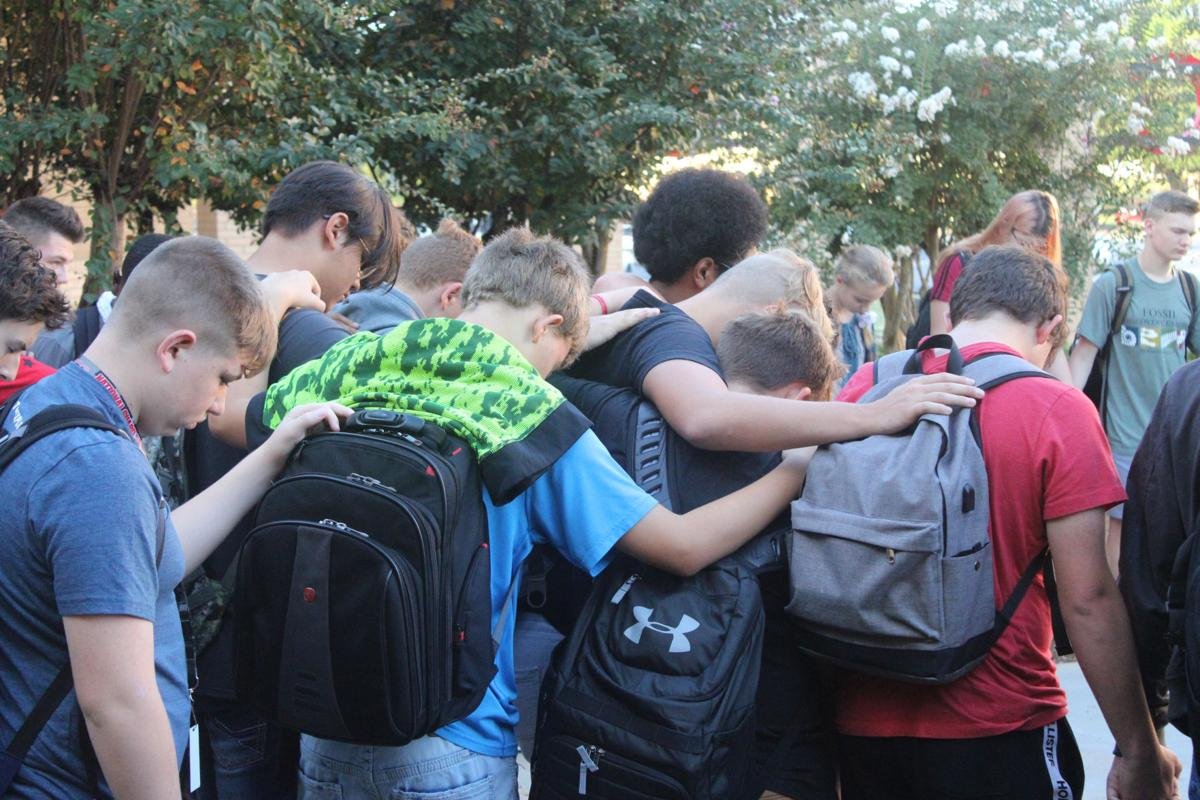
WHY DO WE PRAY?
First, why do we pray? By pointing students to Scripture, they will learn that God’s Word abounds with instruction regarding prayer and that this instruction is relevant to them, even as teens. Contrary to the perspective of some, prayer is not exclusively reserved for pastors, mature adults, or the “spiritually elite.” Instead, continuous prayer is “God’s will in Christ Jesus” and is essential to every believer in every stage of life as a matter of obedience to God’s Word (1 Thess. 5:16-18). Jesus himself demonstrates a life of perfect obedience to God as his life and ministry were fueled by prayer in reliance on the Father.
With this understanding, let us encourage Christian students to imitate Christ’s life of prayer as they submit to the One they have professed as Lord of their life (John 14:15). This submission, however, is not rooted in legalism but in the authenticity of joyful obedience (Psalm 119:47). While there is need to obey, let us also emphasize that there is blessing in obedience and help students see that prayer is a gift for the believer and the church (a gift that Annie so eloquently details in her blog).
Although it is often practiced as a rehearsed formality, prayer is a gift of access to our Sovereign God. This access was made possible only by the precious blood of Christ that tore the veil so we may now approach God with humility and confidence, from any place at any time (1 John 5:14; Matt. 27:50-51; Eph. 3:12; Heb. 4:16). By teaching students this gift of access to God, they may humbly approach and depend on Him in every moment.
Through a posture of obedience and dependence, students are empowered by the Holy Spirit to live out their faith in a world hostile to Christ (Eph. 6:10-18; Acts 5:32; Rom. 8:29). The same is true for the church. In the book of Acts, we see time and time again that the church grew exponentially as believers gathered in prayer with and for one another. Here, we see God’s power on display as He advances His Kingdom in response to His people gathered in prayer (Acts 4:31; Jas. 5:16). Therefore, let us establish a biblical foundation for prayer so students may come to experience God’s power revealed through personal and corporate prayer. To do this, consider the following:
● Evaluate the priority of prayer in your own life. What does your prayer life communicate regarding prayer as a biblically essential discipline?
● Encourage fellow leaders to evaluate the priority of prayer in their personal lives and in the ministry. How well do they believe the ministry does or does not reflect prayer as a biblically essential discipline to students?
● As a student ministry team, come together for a short series to establish a biblical basis for prayer. Invest the time to develop a healthy team of individuals who live out the priority of prayer personally and corporately. Then, re-do this study! Only this time, invite a small group of high school students/leaders to participate. This will prepare these students to join adults and lead the same study for the student ministry.
● Before teaching students, evaluate their preconceived notions and current prayer practices. Provide them with time to reflect on their current understanding of prayer with guided questions followed by measurable responses (such as a 0-10 never/always scale). Provide space for free-text journaling as well.
● At the conclusion of a ministry-wide series centered on the “why” behind prayer, provide the same evaluation referenced above so students (and their leaders) can measure changes based on what they have learned. Provide space for students to develop a response in obedience to God’s Word.
WHY DO WE NOT PRAY?
Secondly, “why do we not pray?” As in, what keeps students from praying? By asking this question, we can help students honestly evaluate their lives so they may identify potential barriers and develop a plan to overcome them. This will require providing an opportunity for students to reflect and openly share intrinsic and extrinsic barriers to prayer. While you may have already addressed an intrinsic barrier for many students by addressing the why behind prayer, there are several more deeply held beliefs or perspectives that may impede a student’s prayer life that have yet to be realized. Additionally, in a world full of distractions and a culture driven by productivity, there are numerous extrinsic factors that complicate our students’ commitment to a disciplined life of prayer. To address barriers to prayer, contemplate these suggestions:
● Gather students and provide them with two sticky notes – one for intrinsic and one for extrinsic barriers to prayer (ask for at least two examples of each). When they have finished, have students post their sticky notes on the wall or board at the front of the room (anonymously if they prefer). After this, read the sticky notes aloud and compile a large list for all students to see. Make this fun and involve the students as you write them out. Ask if anyone can relate to the barrier and be willing to personally relate when applicable. The hope is to get students thinking deeper about their own barriers during this exercise. Then, provide an open forum where students can freely add to this list out loud as a group.
● After providing time for students to share, start a new list and invite students to openly share relevant solutions to the listed barriers. This may help students find practical solutions to their barriers at the recommendation of peers.
● Provide a copy of these comprehensive lists to small group leaders so they may help students develop a plan to overcome barriers to prayer (perhaps this could even be a small group effort). Consider providing a template that will provide consistent structure to this plan for all students in the ministry.
● Small group leaders may then check in weekly to find out how the student’s plan is going and provide encouragement in prayer (consider the audio message option and pray for the student on the spot – let them see prayer in action as it is modeled by an adult they know and trust).
● Encourage fellow small group members to do the same check in with their peers (consider pairing students with a prayer partner(s) to ensure each member is receiving weekly encouragement and prayer from at least one fellow group member – encourage them to extend beyond their one peer as they are led).
HOW DO WE PRAY?
Finally, “how do we pray?” This question immediately brings to mind the disciple’s request of Jesus, “Lord, teach us to pray…” (Luke 11:1, NIV). Jesus did not rebuke this disciple’s request. Rather, he immediately responds with, “When you pray say…”' and provides a model of prayer for His disciples to follow (Matt. 6:9-13; Luke 11:2, NIV). For some of us, this disciple’s request resonates with us personally as we routinely plea for Jesus to teach us to pray. I wonder how life-altering such a request could be if it poured from the heart of the next generation in prayer.
Therefore, as we tell the story of the disciple’s request and Jesus’ gracious response, let us encourage our students to humbly seek the face of the King of Kings and ask him to teach them, as his children, how to pray (2 Chron. 7:14; Jas. 1:5). Then, as you consider your role in teaching students how to pray, contemplate the following:
● Look to Jesus’ model for prayer and establish a basic structure to guide students in following the Lord’s prayer (Matt. 6:9-13).
o Implement one of the many acronyms that follow the Lord’s prayer. Or get creative as a ministry and collaborate with students to develop one.
o Encourage students to memorize the Lord’s prayer. Then, as they recite the Lord’s prayer they can elaborate with personal prayer.
o Demonstrate this structure and provide opportunities for students to put prayer into practice privately and corporately.
● Come alongside students in the development of a personalized prayer plan (create a template that can fit inside their Bible to be easily referenced).
● Teach students to pray authentically, regularly, and with persistence (Matt. 6:7-8; Luke 5:16, 18:1).
● Teach students the necessity of withdrawing in private prayer (Psalm 46:10; Matt. 6:6; Luke 5:16).
● Teach students the necessity of gathering to pray corporately:
o With one another (Acts 1:14)
o For one another (Matt. 19:13; John 17:19)
Although students may be overly familiar with prayer as a mere word, hopefully by biblically addressing these three questions they will come to see and experience prayer as a discipline essential to a thriving walk with Christ. Now, how do we build on this foundation to lead students to pray with and for the lost and saved of their generation? That’s coming up next in part two of this series on prayer! For now, be encouraged to prayerfully consider and creatively address these questions within your own life and ministry context.
WHAT AN HONOR TO CALL STUDENTS TO PRAY!
As we diligently seek to develop a generation of students committed to prayer, may we demonstrate in word and action the essential nature of prayer in our lives and in the ministry entrusted to each of us (Titus 2:7-8). Through it all, may God be glorified as generations of believers wholly surrender to Him in prayer.
~ Sara
INTENTIONALITY - IN YOUR MINISTRY’S CONTENT, CONNECTION, AND COLLABORATION
In ministry we have a choice, either be intentional in our approach to our ministries or not. Either be strategic or stagnant. Either be proactive or passive. Some leaders may take the passive role and not live intentional, even convincing themselves this is the spiritual path as they simply trust in God and His sovereign Hand. Grab a cup of coffee and invest 15 minutes nourishing yourself in the nature of God and how His Word provides clarity on ministry intentionality, especially in relation to our ministries content, connection, and collaboration.
It has been a year, hasn’t it? Actually, it has been a few years now, but who’s counting? Either way, here we are entering another year deeply entrenched in the thick of unprecedented times. These times have undoubtedly tested our faith (Jas. 1:2; 2 Cor. 4:13-18). Yet, as our steadfast faith fuels perseverance, we rejoice and have confidence in the truth that God’s sovereign hand is at work as He molds us in conformity to His Son (Jas. 1:2-3, Rom. 8:28-29; 2 Cor. 1:21 4:13-18; Phil. 2:1-30). A steadfast life of faith and the ministry that follows, however, is cultivated with intentionality. While there has always been a vital need to be intentional in student ministry, the times we find ourselves in today have most assuredly affirmed this need if we are to effectively reach the next generation with the truth of Jesus Christ.
When we speak of intentionality, it is likely a word you know well. In fact, it is quite possible this word has made its mark on your meticulously crafted list of resolutions for the New Year. Or perhaps it is simply a word you have heard all too often but struggle to implement. Regardless of where you land or in what role you serve, you can begin developing a plan to intentionally lead and love the next generation starting today. First, let’s establish a brief biblical basis for intentionality in ministry.
From the very beginning, God demonstrates an intentional purpose and plan for His creation in His Word. Here, we find that God is organized as He created orderly, intricately complex yet balanced systems that sustain the very life and breath He gives (Gen. 2:7; Isa. 42:5; Acts 17:25). God even signals to our Savior early on in Genesis 3, revealing that He has always had a proactive and deliberate plan to rescue and redeem fallen man through Jesus (Gen. 3:15). Certainly, the cross was not an afterthought. As we see God’s kingdom plan unfold across the metanarrative of Scripture, it is evident that He is a God of structure and order (1 Cor. 14:33). Within this structure and order, God’s glory and love is on full display (Psalm 19:1, 104:31-34, 148:3-5, 7; Isa. 40:26; John 3:16; 1 John 4:10, 19; Rom. 5:8). Therefore, we see that organization, structure, and order are good and ought to have a place in our lives and ministries. Though we as believers are reliant on and must remain sensitive to the Holy Spirit, let us embrace intentionality with flexibility as we seek to make disciples of the next generation in obedience to Christ (John 13:34, 16:13; 1 John 4:7-21; Matt. 28:19-20; 1 Cor. 4:2, 14:40; Col. 3:23-24).
As we pursue intentionality in student ministry, we are wise to remember that our window of influence is limited by time. While this is true, we can make the most of every opportunity during the critical years of a student’s spiritual formation (Eph. 5:16). Surely, this is an enormous responsibility that calls us to go beyond mere intentions to develop a plan. The development of an organized and purposeful plan not only casts vision for the ministry but also paves the way for effective spiritual leadership at a sustainable pace. So, let’s get started!
STUDENT MINISTRY DOES NOT FUNCTION IN A CALENDAR YEAR!
When the world rings in the New Year and thinks about new aspirations, goals, and resolutions, we are already halfway through our ministry year and thinking (or should be) about summer camp, mission trips and the fall retreat. Use this winter season to begin thinking about the soon coming ministry year. Be intentional!
To begin, let’s consider that although we just rang in the New Year, the student ministry year has only recently passed the half-way point. Since student ministry aligns with the school calendar from August to approximately May/June, the New Year serves as a premier time to begin calibrating for the upcoming school year. This time allows us to evaluate where the ministry has been, where it is at, and where it is headed in accordance with the ministry’s biblical philosophy. Then, we may begin prayerfully and strategically planning with purpose and direction. To do this, be encouraged to prayerfully consider and further develop the following three Cs of intentionality within your own student ministry context:
Intentionality in Content
Intentionality in Connection
Intentionality in Collaboration
INTENTIONALITY IN CONTENT
In our commitment to deliver sound, biblical content firmly rooted in the authoritative Word of God, there is much to consider. As Jesus commissions his disciples, he instructs them to make disciples by “teaching them to obey everything I have commanded you” (Matt. 28:19-20, NIV). While this requires our diligence in properly handling God’s Word, we ought to develop a strategic teaching plan to faithfully impart the “whole counsel of God” to the next generation (2 Tim. 2:15; Acts 20:27, ESV). As you look ahead, contemplate the following in the development of your teaching plan:
Take inventory of the time entrusted to you based on the current structure of the ministry.
How much time do you really have to teach students the Word of God over the course of their time in student ministry?
Establish the specifics of biblical content to be delivered over the course of this time.
Establish when this content will be delivered.
Establish how this content will be delivered.
Once a teaching plan is fully developed, it may then be communicated to the student ministry team. This will allow leaders to focus on reinforcing specific biblical content as they engage students one on one or in small group settings.
INTENTIONALITY IN CONnection
Without question, relationships with students are vital to the health of the ministry. We have all heard of and even witnessed some of the countless lives that have been eternally impacted for Christ within the context of meaningful relationships. For some of us, we have experienced this firsthand and bear witness to the impact of a relationship in our own personal testimony of faith in Christ. Either way, relationships are essential. With this knowledge, let us prioritize reaching into our students’ world by developing a personal connection strategy. As you develop this strategy, consider the following:
What opportunities can I take hold of in an effort to meet lost students on their terms within the community?
How can the ministry create an inviting environment where lost students desire to be on a routine basis?
How can I cultivate a connection already formed with saved students?
How can I encourage saved students to form connections with lost peers?
How can I effectively utilize a digital platform or social media to establish and build a relevant connection with both lost and saved students?
After you have brainstormed creative yet practical ways to establish and build a connection with students, you may then construct a plan to implement your personal connection strategy.
INTENTIONALITY IN COllaboration
While the Lord has impressed on our hearts a burning desire to reach the next generation, we are not alone in this pursuit. Not only does Jesus assure us of his presence with us, but we have also been unified as members of one body of believers to advance the kingdom under his headship (Matt. 28:20; John 14:16-17, 16:13-14; John 17:21; Rom. 12:4-5; 1 Cor. 12:12-31; Eph. 4:11-16; Col. 1:18). Though students are designated as “the next generation,” they are of vital importance to the body of Christ today. Therefore, let us resist isolating the student ministry from the church body and develop a strategic plan for collaboration with the church. As you develop this plan, consider the following:
How can students be more visible, active participants within the church?
How can students serve and engage the church?
How can the entire body serve and support students within and outside of the church?
How can students be encouraged and embraced as vital members of the body of Christ?
How can intergenerational relationships be fostered within the church?
When generations of believers intentionally come together, the church may more effectively reach a diverse range of lost students for Christ while also building up saved students in the body. Students may then begin to see that the church is not a “place” they will one day attend by virtue of age. Instead, they will come to experience the church as a living body of believers to which they and all believers belong, unified in Christ for the purpose of advancing the gospel (Eph. 4:11-16).
Hopefully, each of these three Cs will serve as a starting point in the development of your plan for intentionality in ministry. As you consider each one, be encouraged to approach the three Cs from various angles. Although they have been specifically approached here with a focus on ministry to students, you may consider approaching the three Cs with the goal of developing a plan for intentionality in ministry to parents. Surely, the vital role of parents as the primary disciple makers of their children cannot be overemphasized. Ultimately, seek the Lord and his wisdom as you prayerfully consider and develop a plan to effectively minister for His glory (Prov. 16:3, 9; 19:21, 21:5; James 4:13-15).
“YOUTH LEADER, YOU ARE INVESTING INTO OTHERS…WHO IS INVESTING INTO YOU?”
Before you go and begin building upon the three Cs, please allow me to impart a few final words of encouragement. First, “thank you.” Though we find ourselves in uncertain times, thank you for fixing your eyes on Christ and persevering in your commitment to him for the sake of the gospel (1 Cor. 9:23). Secondly, while various elements of student ministry like strategic planning may energize some, it can be flat out overwhelming for others. In recognition of this, be encouraged to partner with other like-minded believers as you pursue obedience to the Lord’s call on your life. Finally, know that NextGen Matters (NGM) is here to pour into you as you faithfully pour into students. Whether you serve vocationally or as a volunteer in student ministry, NGM is committed to intentionality in content, connection, and collaboration with you in mind. With this understanding, I would like to encourage you to stay connected with us by clicking here, in this very moment, to sign up for NGM’s newsletter. Beyond signing up, please accept this invitation for you and your team to join us from wherever you are for various events. During these events, student leaders from all over the country come together virtually to build one another up in Christ and “earnestly contend” for the faith so graciously entrusted to us (1 Thess. 5:11; Jude 1:3, ESV). May you know that you have a place here among a family of believers committed to serving the Lord and the next generation alongside one another.
Wrapping it Up!
Now, as you enter this New Year with a renewed focus on intentionality, may you “press on toward the goal for the prize of the upward call of God in Christ Jesus” (Phil. 3:12-14, ESV). In turn, may generations upon generations come to know the absolute truth of Christ and find their eternal hope in him alone (Psa. 78:4-7).
~ Sara










